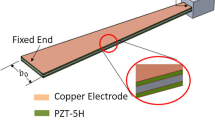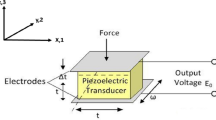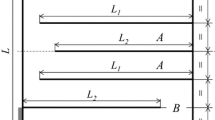Abstract
Energy harvesting is the technology which scavenges energy from the ambient sources of energy. Several researches are moving in the field of energy harvesting to get maximum output power from the ambient sources. This paper deals with the optimization on the dimensions of a piezoelectric energy harvester(PEH) which can work at low frequency using different piezoelectric materials. An analysis of a rectangular block-shaped geometry was done with its height and length varied to study the effect of length and height of the geometry with its natural frequency. Thus, the optimized geometry was used as a piezoelectric energy harvester by using a fixed constraint at one end. An electrical circuit with a resistor is connected to the PEH device, which measures the output voltage and current through the device. An optimized dimension of 100 mm \(\times \) 1 mm for the nanogenerator with PVDF material yielded a good performance including maximum current and voltage at low frequencies of 0–30 Hz. The study of perturbations was implemented on the optimized geometry of the piezoelectric material, which reduced its resonant frequency to 11.96 from 1373.05 Hz.
Access provided by Autonomous University of Puebla. Download conference paper PDF
Similar content being viewed by others
Keywords
- Energy harvesters (PENG)
- Piezoelectricity
- Polarization
- Nanogenerators
- Resonant frequency
- Voltage conversion efficiency
1 Introduction
Energy harvesting is the technology which scavenges energy from the ambient sources of energy like sun, wind, thermal energy, etc., and converts it into some usable energy like electrical energy which is either directly used or stored it for some of the devices like sensor networks, wearable devices, etc. With the recent research and emerging trend, this energy harvesting technique is a better alternative for conventional battery. There are different ways of energy harvesting like photovoltaic energy harvesting, thermoelectric energy harvesting, electromagnetic energy harvesting, piezoelectric energy harvesting, pyroelectric energy harvesting, triboelectric energy harvesting, etc. [1]. Among them, piezoelectric energy harvesting attains a relevant importance because it works on the basis of vibrations, and these vibrations are abundantly available in nature. Piezoelectricity is the phenomenon when a stress is applied on the material, an electrical energy is generated. This is called direct piezoelectric effect. A material deformation is observed when an electric field is applied on piezoelectric material. This phenomenon is known as converse piezoelectric effect. This direct piezoelectric effect can be used to convert some forms of vibrational energy into an electric energy, and it can be stored and used in low-power electronic devices to make it self-powering [2].
The four main categories of piezoelectric materials that are used for the energy harvesting applications are as follows [3]:
-
Single crystals (include Lithium niobite, Rochelle salt and quartz crystals)
-
PiezoCeramics (barium titanate (BaTiO3), potassium niobite (KNbO3), lead zirconate titanate (PZT))
-
PiezoPolymers (cellulose and derivatives , polylactic acid (PLA), polyvinylidene fluoride (PVDF))
-
Polymer composites or nanocomposites (polyvinylidene fluoride—zinc oxide, cellulose BaTiO3, polyimides-PZT)
When these materials are manipulated into nanometer size range, they can be used in various implantable and wearable devices as nanogenerators, so that they can harvest energy from body motions like breathing, muscle movements, walking, joint motion, etc. Since the input energy to these nanogenerators is of low frequency, the authors aim to study the dimensional optimization of some piezoelectric materials which can operate at low frequencies to self-power some low-power devices.
2 Materials and Methods
2.1 Materials
The piezoelectric material used for the study includes aluminium nitride(AlN) [4], cadmium sulphide(CdS) [5] and polyvinylidene fluoride(PVDF). One of the newest material which is added in the ceramic family is AlN, which is a covalently bonded material with a hexagonal structure. They have good thermal conductivity, mechanical properties, electrical insulation and dielectric insulation. Cadmium sulphide is a yellow-coloured inorganic compound with two different crystal structures. CdS is a direct band gap semiconductor with a piezoelectric effect. PVDF is a fluoropolymer which is thermoplastic in nature and also non-reactive. Its piezoelectricity is very large, when this PVDF film is poled, it produces piezoelectricity ten times larger than other polymers. The different properties like piezoelectric coefficient, density, Young’s modulus, relative permittivity and Poisson’s ratio are illustrated in Table 1.
2.2 Methods
To study piezoelectric effect, Comsol Multiphysics software was used by choosing “Physics” as piezoelectricity, so that solid mechanics and electrostatics physics will appear automatically into the model builder window as piezoelectric effect includes strain and electricity. Under the global parameters, different variables for dimension optimization can be given so that a parametric analysis of these variables can be studied to obtain an optimum result. To analyse a piezoelectric energy harvesting device [6,7,8,9], an electric circuit has to be enabled by connecting an external terminal to the device.
2.3 Geometry of the Nanogenerator
A rectangular block with three sides as a variable length, breadth and height is chosen. Length is varied from 10 to 100 mm, and height is varied from 1 to 10 mm. Figure 2a shows the image of the geometry chosen. A boundary load of 0.5 N is applied in the \(-z\) direction of the piezoblock. In order to reduce the resonant frequency, perturbations with width of the perturbation (\(w_{1}\)) varying from 0.1 to 1 mm and space between the perturbation (s) varying from 0.1 to 0.3 mm were implemented into the piezoblock as depicted in Fig. 2b.
3 Results and Discussions
3.1 Analysis of Piezoelectric Materials by Varying Length
The length of rectangular block of AlN, CdS and PVDF kept varying from 10 to 100 mm by keeping breadth as 10 mm and height as 1 mm. The Eigen frequency and floating potential are calculated, and the results are depicted in Tables 2 and 3, respectively.
As per the table, it is understood that as the length of the material increases, the resonant frequency of the material decreases, i.e. the resonant frequency is inversely proportional to the length squared as per the fundamental frequency of a singly clamped Euler–Bernoulli beam with a rectangular cross section of Eq. (1) [10,11,12]. The breadth variation by keeping length constant resembles same as that of the length variation. From the result, it is observed that only PVDF responds at low frequencies, and the floating potential for PVDF decreases when the length increases. CdS shows a better result compared to AlN at lower lengths.
where E is the Young’s modulus and L is the length.
3.2 Analysis of Piezoelectric Materials by Varying Height
The height of all the three selected materials is varied from 1 to 10 mm by keeping the length as 100 mm and breadth as 10 mm. The results for Eigen frequency and floating potential are illustrated in Tables 4 and 5, respectively. Due to software limitation, the length is reduced from 10 to 9 mm. The results show that resonant frequency increases with increase in height and obeys Eq. (1). In this case, also PVDF shows good results at lower frequencies [11].
3.3 Analysis by Inserting Electric Circuit
A resistor of 1000 \(\Omega \) is added to the piezoelectric block. The voltage across the resistor is obtained and depicted in Table 6. The graph for the voltage when frequency varied from 0 to 1000 Hz is shown Fig. 4a. From Fig. 3a, it is clear that only PVDF [13,14,15,16] has high output voltage. Figure 4b emphasizes the performance of PVDF at the lower frequency of 20 Hz. CdS also shows a better result but at higher frequency than that of PVDF.
a Length versus Eigen frequency for AlN, CdS and PVDF. (Length in mm and freq in Hz) b Length versus floating potential for AlN, CdS and PVDF. (Length in mm and floating potential in volts. c Height versus Eigen frequency (Height in mm and freq in Hz) d Height versus floating potential. (Height in mm and potential in volts)
3.4 Efficiency of the Optimized Piezoelectric Material
Efficiency of energy harvesting is defined as the ratio of output electrical power to the input mechanical power. The efficiency for all the three materials is analysed, and PVDF is having high efficiency at the low frequency of 20 Hz, which is the resonant frequency of the analysed PEH device [17]. The efficiency graph for all the three materials is depicted in Fig. 4c.
3.5 Analysis by Varying Resistance
The resistance(in \(\Omega \)) connected to the electric circuit is varied from 100 to 1000 ohm, and voltage (in V) across the resistor is studied. The results are shown in Table 7, and corresponding figures are depicted in Fig. 5a. From the table, it is clear that as the resistance increases, the voltage increases (Fig. 5).
3.6 Analysis by Incorporating Perturbations in PVDF Material
From the optimization of AlN, CdS and PVDF discussed above, it is clear that PVDF can work at low frequencies, with high efficiencies. So the further step aims to reduce the resonant frequency at smaller lengths to use it in some personal equipments for self-powering.
When length and breadth equal 10 mm, PVDF produced a resonant frequency of 13073.05 Hz, which is very high. To reduce the Eigen frequency, the length of the material is increased, since they are having inverse relations. Increasing length cannot find applications in low-frequency devices [18,19,20] so some perturbations are introduced in the PVDF material by keeping the length and breadth as 10 mm and height 1 mm, respectively. The configuration is shown in Fig. 2b. A rectangular spiral was inserted into the rectangular PVDF block and studied the effect of width of the perturbations (\(w_1\)) on frequency and also the spacing between the perturbation (s) on the resonant frequencies [21, 22]. The possible combinations of w1 and s with resonant frequency less than 100 Hz are illustrated in Table 8. Also their relationships are plotted in Fig. 5c,d.
From Fig. 5c, d, it is understood that as the width of the spiral and spacing between the spiral increases, the Eigen frequency also increases. The reason behind this shift can be studied from Eq. (3), which shows that the resonant frequency is inversely proportional to the inductance and capacitance.
When spiral perturbations are introduced, the mutual capacitance produced due to the spacing(s) between the spirals and mutual inductance produced due to the interactions of field due to the current flow through the spiral increase, so as a result the resonant frequency will be decreased or shifted to the lower side of the frequency graph. When spacing between the spirals is less, the mutual capacitance will be more resulting in lower resonant frequencies. To study the voltage, a resistance of 1k\(\Omega \) is connected and kept w1 as 0.5 mm and s as 0.2 mm. The voltage for this specification is shown in Table 9 and Fig. 5b. When perturbations are introduced, the voltage is more at their resonant frequencies when compared to the one without perturbations.
4 Conclusion
An optimization of piezoelectric materials like AlN, CdS and PVDF is done to find the apt piezoelectric material which is suited to operate at low frequencies. In the length-varying analysis, it is obtained that as the length increases, resonant frequency decreases, and in the height variation it is obtained as the resonant frequency increases with the increase in the height. From the Eigen frequency study, it is observed that PVDF is the best material which can operate at low frequencies. In the frequency domain, study with an electrical circuit also shows that PVDF responds with high voltage at low frequencies. The voltage conversion efficiency for PVDF is high at its low resonant frequency of 20 Hz. But increasing length to adjust the resonant frequency is not practical, while using them in wearable electronics. To compensate the limitation of increase in length with decrease in frequency, perturbations are introduced into the geometry, which reduces the resonant frequency even at lower lengths. The PVDF material with length and breadth of 10 mm and height 1 mm produced a resonant frequency of 13073.05 Hz, but by incorporating the spiral perturbations (\(w_1\) = 0.1 mm and s = 0.1 mm) the resonant frequency reduced to 11.96 Hz. Thus, in the implementation of perturbations in the PVDF material with the optimized geometry, it can be suited in several wearable devices. With the PVDF material, adjusting the design with perturbations can be a next stage of PEH design for the researchers.
References
Sarma AS, Sreekala CO, Menon SK (2020) Microstrip fed monopole antenna on Barium Titanate-PDMS substrate. Mater Today Proc 33:1308–1311. https://doi.org/10.1016/j.matpr.2020.04.087
Covaci C, Gontean A (2020) Piezoelectric energy harvesting solutions: a review. Sensors 20(12):3512. Multidisciplinary Digital Publishing Institute
Prakash Raju GKS, Ashok Kumar P, Srinivasa Rao KS, Aravapalli V (2017) Design and simulation of cantilever based MEMS bimorph piezoelectric energy harvester. Mech Mater Sci Eng J 9(1). https://doi.org/10.2412/mmse.16.9.490
Gu L (2011) Low-frequency piezoelectric energy harvesting prototype suitable for the MEMS implementation. Microelectron J 42(2):277–282. Elsevier
Harb A (2011) Energy harvesting: state-of-the-art. Renew Energy 36(10):2641–2654. (Elsevier)
Hullavarad NV, Hullavarad SS, Karulkar PC (2008) Cadmium sulphide (CdS) nanotech-nology: synthesis and applications. J Nanosci Nanotech 8(7):3272–3299. American Scientific Publishers
Li H, Tian C, Deng ZD (2014) Energy harvesting from low frequency applications using piezoelectric materials. Appl Phys Rev 4:041301. (AIPPublishing LLC)
Liu H, Lee C, Kobayashi T, Tay CJ, Quan C (2012) A new S-shaped MEMS PZTcantilever for energy harvesting from low frequency vibrations below 30 Hz. Microsystemtechnologies 18(4):497–506. (Springer)
Lu L, Ding W, Liu J, Yang B (2020) Flexible PVDF based piezoelectric nanogenerators. Nano Energy 105251. (Elsevier)
Massaro A, De Guido S, Ingrosso I, Cingolani R, De Vittorio M, Cori M, Bertac-chini A, Larcher L, Passaseo A (2011) Freestanding piezoelectric rings for high efficiencyenergy harvesting at low frequency. Appl Phys Lett 98(5):053502. (American Institute of Physics)
Mercy A, Selvaraj RS, Boaz BM, Anandhi A, Kanagadurai R (2013) Synthesis, struc-tural and optical characterisation of cadmium sulphide nanoparticles. NISCAIR-CSIR, India
Mhetre MR, Nagdeo NS, Abhyankar HK (2011) Micro energy harvesting for biomedicalapplications: a review. In: 2011 3rd international conference on electronics computer technology, vol 3. IEEE, pp 1–5
Mishra S, Unnikrishnan L, Nayak SK, Mohanty S (2019) Advances in piezoelectric poly-mer composites for energy harvesting applications: a systematic review. Macromol Mater Eng 304(1):1800463. (Wiley Online Library)
Chandran R, Sreekala CO, Menon SK (2020) BaTiO3/V2O5 composite based cylindrical dielectric resonator antenna for X-band applications. Mater Today Proc 33:1367–1370
Selvarathinam J, Anpalagan A (2016) Energy harvesting from the human body for biomed-ical applications. IEEE Potentials 35(6):6–12. (IEEE)
Sreeja SDB, Gopalan S, Sreekala CO (2019) Piezoelectric energy harvesting system suitable for remotely placed sensors with inter-digitated design. AIP Conf Proc 2162(1):020052
Rajeev SP, John SK, Cherian R, Karumuthil SC, Varghese S (2020) Next-generation rooftop tribo-piezoelectric energy harvesting from rain power. Appl Nanosci 10(3):679–686
Rajeev SP, Sivapriya S, Cherumannil Karumuthil S, Varghese S (2020) Prototype of energy harvesting door handles using polymer nanocomposite. Appl Nanosci 10(1):1–13
Rajeev SP, John VN, Sabarinath S, Ashfak A, Subash CK, Varghese S (2020) Nature-inspired PDMS cumulonimbus micro-energy-harvesting cloud. Appl Nanosci
Suhailrashid S, Sreekala CO, Menon SK (2019) Dielectric resonator antenna on Ba \(\text{TiO}_3\) embedded with \(\text{ TiO}_2\) nano composite for Wi-Fi applications. IOP Conf Ser Mater Sci Eng 577:012190
Siang J, Lim MH, Salman Leong M (2018) Review of vibration-based energy harvesting technology: mechanism and architectural approach. Int J Energy Res 42(5):1866–1893. (Wiley Online Library)
Tiwari S, Gaur A, Kumar C, Maiti P (2019) Enhanced piezoelectric response in nanoclayinduced electrospun PVDF nanofibers for energy harvesting. Energy 171:485–492. (Elsevier); Zhao Y, Peng X, Fu T, Huang C, Xiang H, Hu N, Yan C (2018) Investigation ofmechanical behaviour of amorphous aluminium nitride. Materialia 2:148–156. (Elsevier)
Author information
Authors and Affiliations
Corresponding author
Editor information
Editors and Affiliations
Rights and permissions
Copyright information
© 2022 The Author(s), under exclusive license to Springer Nature Singapore Pte Ltd.
About this paper
Cite this paper
Panicker, S.S., Sreenidhi, P.R. (2022). Dimensional Optimization of Low-Frequency Piezoelectric Nanoenergy Harvesters. In: Bindhu, V., R. S. Tavares, J.M., Ţălu, Ş. (eds) Proceedings of Fourth International Conference on Inventive Material Science Applications. Advances in Sustainability Science and Technology. Springer, Singapore. https://doi.org/10.1007/978-981-16-4321-7_4
Download citation
DOI: https://doi.org/10.1007/978-981-16-4321-7_4
Published:
Publisher Name: Springer, Singapore
Print ISBN: 978-981-16-4320-0
Online ISBN: 978-981-16-4321-7
eBook Packages: Chemistry and Materials ScienceChemistry and Material Science (R0)









